分子模拟第一章
- 格式:ppt
- 大小:681.50 KB
- 文档页数:20

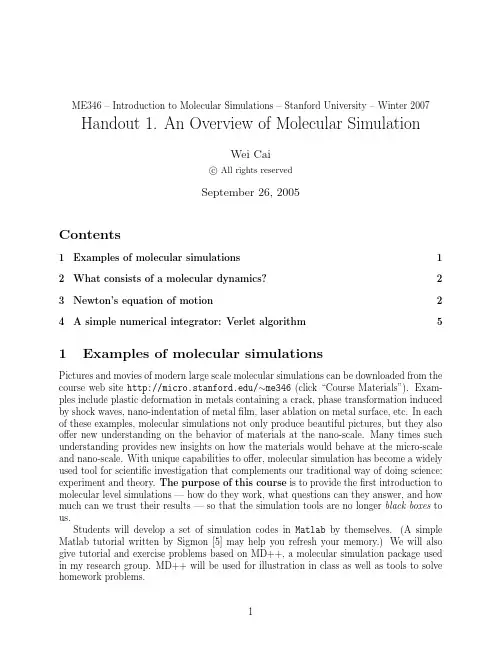
ME346–Introduction to Molecular Simulations–Stanford University–Winter2007 Handout1.An Overview of Molecular SimulationWei Caic All rights reservedSeptember26,2005Contents1Examples of molecular simulations1 2What consists of a molecular dynamics?2 3Newton’s equation of motion2 4A simple numerical integrator:Verlet algorithm5 1Examples of molecular simulationsPictures and movies of modern large scale molecular simulations can be downloaded from the course web site /∼me346(click“Course Materials”).Exam-ples include plastic deformation in metals containing a crack,phase transformation induced by shock waves,nano-indentation of metalfilm,laser ablation on metal surface,etc.In each of these examples,molecular simulations not only produce beautiful pictures,but they also offer new understanding on the behavior of materials at the nano-scale.Many times such understanding provides new insights on how the materials would behave at the micro-scale and nano-scale.With unique capabilities to offer,molecular simulation has become a widely used tool for scientific investigation that complements our traditional way of doing science: experiment and theory.The purpose of this course is to provide thefirst introduction to molecular level simulations—how do they work,what questions can they answer,and how much can we trust their results—so that the simulation tools are no longer black boxes to us.Students will develop a set of simulation codes in Matlab by themselves.(A simple Matlab tutorial written by Sigmon[5]may help you refresh your memory.)We will also give tutorial and exercise problems based on MD++,a molecular simulation package used in my research group.MD++will be used for illustration in class as well as tools to solve homework problems.2What consists of a molecular dynamics?In a molecular simulation,we view materials as a collection of discrete atoms.The atoms interact by exerting forces on each other and they follow the Newton’s equation of motion. Based on the interaction model,a simulation compute the atoms’trajectories numerically. Thus a molecular simulation necessarily contains the following ingredients.•The model that describes the interaction between atoms.This is usually called the interatomic potential:V({r i}),where{r i}represent the position of all atoms.•Numerical integrator that follows the atoms equation of motion.This is the heart of the ually,we also need auxiliary algorithms to set up the initial and bound-ary conditions and to monitor and control the systems state(such as temperature) during the simulation.•Extract useful data from the raw atomic trajectory pute materials properties of interest.Visualization.We will start our discussion with a simple but complete example that illustrates a lot of issues in simulation,although it is not on the molecular scale.We will simulate the orbit of the Earth around the Sun.After we have understood how this simulation works(in a couple of lectures),we will then discuss how molecular simulations differ from this type of “macro”-scale simulations.3Newton’s equation of motionThroughout this course,we limit our discussions to classical dynamics(no quantum mechan-ics).The dynamics of classical objects follow the three laws of Newton.Let’s review the Newton’s laws.Figure1:Sir Isaac Newton(1643-1727England).First law:Every object in a state of uniform motion tends to remain in that state of motion unless an external force is applied to it.This is also called the Law of inertia.Second law:An object’s mass m,its acceleration a,and the applied force F are related byF=m a.The bold font here emphasizes that the acceleration and force are vectors.Here they point to the same direction.According to Newton,a force causes only a change in velocity(v)but is not needed to maintain the velocity as Aristotle claimed(erroneously).Third law:For every action there is an equal and opposite reaction.The second law gives us the equation of motion for classical particles.Consider a particle (be it an atom or the Earth!depending on which scale we look at the world),its position is described by a vector r=(x,y,z).The velocity is how fast r changes with time and is also a vector:v=d r/dt=(v x,v y,v z).In component form,v x=dx/dt,v y=dy/dt,v z=dz/dt. The acceleration vector is then time derivative of velocity,i.e.,a=d v/dt.Therefore the particle’s equation of motion can be written asd2r dt2=Fm(1)To complete the equation of motion,we need to know how does the force F in turn depends on position r.As an example,consider the Earth orbiting around the Sun.Assume the Sun isfixed at origin(0,0,0).The gravitational force on the Earth is,F=−GmM|r|2·ˆe r(2)whereˆe r=r/|r|is the unit vector along r direction.|r|=√x2+y2+z2is the magnitudeof r.m is the mass of the Earth(5.9736×1024kg),M is mass of the Sun(1.9891×1030kg), and G=6.67259×10−11N·m2/kg2is gravitational constant.If we introduce a potential field(the gravitationalfield of the Sun),V(r)=−GmM|r|(3)Then the gravitational force can be written as minus the spatial derivative of the potential,F=−dV(r)d r(4)In component form,this equation should be interpreted as,F x=−dV(x,y,z)dxF y=−dV(x,y,z)dyF z=−dV(x,y,z)dzNow we have the complete equation of motion for the Earth:d2r dt2=−1mdV(r)d r(5)in component form,this reads,d2x dt2=−GMx|r|3d2y dt2=−GMy|r|3d2z dt2=−GMz|r|3In fact,most of the system we will study has a interaction potential V(r),from which the equation of motion can be specified through Eq.(5).V(r)is the potential energy of the system.On the other hand,the kinetic energy is given by the velocity,E kin=12m|v|2(6)The total energy is the sum of potential and kinetic energy contributions,E tot=E kin+V(7) When we express the total energy as a function of particle position r and momentum p=m v, it is called the Hamiltonian of the system,H(r,p)=|p|22m+V(r)(8)The Hamiltonian(i.e.the total energy)is a conserved quantity as the particle moves.To see this,let us compute its time derivative,dE tot dt =m v·d vdt+dV(r)d r·d rdt=md rdt·−1mdV(r)d r+dV(r)d r·d rdt=0(9)Therefore the total energy is conserved if the particle follows the Newton’s equation of motion in a conservative forcefield(when force can be written in terms of spatial derivative of a potentialfield),while the kinetic energy and potential energy can interchange with each other.The Newton’s equation of motion can also be written in the Hamiltonian form,d r dt =∂H(r,p)∂p(10)d p dt =−∂H(r,p)∂r(11)Hence,dH dt =∂H(r,p)∂r·d rdt+∂H(r,p)∂p·d pdt=0(12)Figure2:Sir William Rowan Hamilton(1805-1865Ireland).4A simple numerical integrator:Verlet algorithmA dynamical simulation computes the particle position as a function of time(i.e.its trajec-tory)given its initial position and velocity.This is called the initial value problem(IVP). Because the Newton’s equation of motion is second order in r,the initial condition needs to specify both particle position and velocity.To solve the equation of motion on a computer,thefirst thing we need is to discretize the time.In other words,we will solve for r(t)on a series of time instances t ually the time axis is discretized uniformly:t i=i·∆t,where∆t is called the time step.Again,the task of the simulation algorithm is tofind r(t i)for i=1,2,3,···given r(0)and v(0).The Verlet algorithm begins by approximating d2r(t)/dt2,d2r(t) dt2≈r(t+∆t)−2r(t)+r(t−∆t)∆t2(13)Thusr(t+∆t)−2r(t)+r(t−∆t)∆t2=−1mdV(r(t))dr(14)r(t+∆t)=2r(t)−r(t−∆t)−∆t·1m·dV(r(t))dr(15)Therefore,we can solve r(t+∆t)as along as we know r(t)and r(t−∆t).In other words,if we know r(0)and r(−∆t),we can solve for all r(t i)for i=1,3,4,···.Question:Notice that to start the Verlet algorithm we need r(0)and r(−∆t).However, the initial condition of a simulation is usually given in r(0)and v(0).How do we start the simulation when this initial condition is specified?References1.Alan and Tildesley,Computer Simulation of Liquids,(Oxford University Press,1987)pp.71-80.2.Frenkel and Smit,Understanding Molecular Simulation:From Algorithms to Applica-tions,2nd ed.(Academic Press,2002).3.Bulatov and Cai,Computer Simulation of Dislocations,(Oxford University Press,2006)pp.49-51.ndau and Lifshitz,Mechanics,(Butterworth-Heinemann,1976).5.Kermit Sigmon,Matlab Primer,Third Edition,/Matlab/matlab-primer.pdfME346–Introduction to Molecular Simulations–Stanford University–Winter2007 Handout2.Numerical Integrators IWei Caic All rights reservedJanuary12,2007Contents1Which integrator to use?1 2Several versions of Verlet algorithm2 3Order of accuracy3 4Other integrators4 1Which integrator to use?In the previous lecture we looked at a very simple simulation.The Newton’s equation of motion is integrated numerically by the original Verlet algorithm.There are many algorithms that can be used to integrate an ordinary differential equation(ODE).Each has a its own advantages and disadvantages.In this lecture,we will look into more details at the numerical integrators.Our goal is to be able to make sensible choices when we need to select a numerical integrator for a specific simulation.What questions should we ask when choosing an integrator?Obviously,we would like something that is both fast and accurate.But usually there are more issues we should care about.Here are a list of the most important ones(Allen and Tildesley1987):•Order of accuracy•Range of stability•Reversibility•Speed(computation time per step)•Memory requirement(as low as possible)•Satisfying conservation law•Simple form and easy to implementItem1and2(especially2)are important to allow the use of long time steps,which makes the simulation more efficient.2Several versions of Verlet algorithmThe Verlet algorithm used in the previous lecture can be written as,r(t+∆t)=2r(t)−r(t−∆t)+a(t)·∆t2(1)wherea(t)=−1mdV(r(t))d r(t)(2)While this is enough to compute the entire trajectory of the particle,it does not specify the velocity of the particle.Many times,we would like to know the particle velocity as a function of time as well.For example,the velocity is needed to compute kinetic energy and hence the total energy of the system.One way to compute velocity is to use the followingapproximation,v(t)≡d r(t)dt≈r(t+∆t)−r(t−∆t)2∆t(3)Question:if the initial condition is given in terms of r(0)and v(0),how do we use the Verlet algorithm?Answer:The Verlet algorithm can be used to compute r(n∆t)for n=1,2,···provided r(−∆t)and r(0)are known.The task is to solve for r(−∆t)given r(0)and v(0).This is achieved from the following two equations,r(∆t)−r(−∆t)2∆t=v(0)(4)r(∆t)−2r(0)+r(−∆t)∆t2=−1mdV(r(t))d r(t)t=0(5)Exercise:express r(−∆t)and r(∆t)in terms of r(0)and v(0).Therefore,r(−∆t)and r(∆t)are solved together.During the simulation,we only know v(t)after we have computed(t+∆t).These are the(slight)inconveniences of the(original) Verlet algorithm.As we will see later,in this algorithm the accuracy of velocity calculation is not very high(not as high as particle positions).Several modifications of the Verlet algorithms were introduced to give a better treatment of velocities.The leap-frog algorithm works as follows,v(t+∆t/2)=v(t−∆t/2)+a(t)·∆t(6)r(t+∆t)=r(t)+v(t+∆t/2)·∆t(7) Notice that the velocity and position are not stored at the same time slices.Their values are updated in alternation,hence the name“leap-frog”.For a nice illustration see(Allen and Tildesley1987).This algorithm also has the draw back that v and r are not known simultaneously.To get velocity at time t,we can use the following approximation,v(t)≈v(t−∆t/2)+v(t+∆t/2)2(8)The velocity Verlet algorithm solves this problem in a better way.The algorithm reads,r(t+∆t)=r(t)+v(t)∆t+12a(t)∆t2(9)v(t+∆t/2)=v(t)+12a(t)∆t(10)a(t+∆t)=−1mdV(r(t+∆t))d r(t+∆t)(11)v(t+∆t)=v(t+∆t/2)+12a(t+∆t)∆t(12)Exercise:show that both leap-frog and velocity Verlet algorithms gives identical results as the original Verlet algorithm(except forfloating point truncation error).3Order of accuracyHow accurate are the Verlet-family algorithms?Let’s take a look at the original Verletfirst. Consider the trajectory of the particle as a continuous function of time,i.e.r(t).Let us Taylor expand this function around a given time t.r(t+∆t)=r(t)+d r(t)dt∆t+12d2r(t)dt2∆t2+13!d3r(t)dt3∆t3+O(∆t4),(13)where O(∆t4)means that error of this expression is on the order of∆t4.In other words, (when∆t is sufficiently small)if we reduce∆t by10times,the error term would reduce by 104times.Replace∆t by−∆t in the above equation,we have,r(t−∆t)=r(t)−d r(t)dt∆t+12d2r(t)dt2∆t2−13!d3r(t)dt3∆t3+O(∆t4),(14)Summing the two equations together,we have,r(t+∆t)+r(t−∆t)=2r(t)+d2r(t)dt2∆t2+O(∆t4)≡2r(t)+a(t)∆t2+O(∆t4)(15)r(t+∆t)=2r(t)−r(t−∆t)+a(t)∆t2+O(∆t4)(16) Therefore,the local accuracy for the Verlet-family algorithms is to the order of O(∆t4). This is quite accurate for such a simple algorithm!The trick here is that,by adding t+∆t and t−∆t terms,the third order term cancels out.Notice that the accuracy analysis here deals with the local error.That is,assuming r(t)is exact,how much error we make when computing r(t+∆t).In practice,the total error of computed r at time t is the accumulated (and possibly amplified)effect of all time steps before time t.Because for a smaller timestep ∆t more steps is required to reach a pre-specified time t,the global order of accuracy is always local order of accuracy minus one.For example,the global order of accuracy for Verlet algorithms is3.Since all Verlet-family algorithms generate the same trajectory,they are all O(∆t4)in terms of particle positions.But they differ in velocity calculations.How accurate is the velocity calculation in the original Verlet algorithm?Let us subtract Eq.(13)and(14),r(t+∆t)−r(t−∆t)=2v(t)∆t+13d3r(t)dt3∆t3+O(∆t4),(17)v(t)=12∆tr(t+∆t)−r(t−∆t)−16d3r(t)dt2∆t3+O(∆t3)(18)v(t)=r(t+∆t)−r(t−∆t)2∆t+O(∆t2)(19)Thus the velocity is only accurate to the order of O(∆t2)!This is much worse than O(∆t4) of the positions.A reason for the lose of accuracy is that the velocities are computed by taking the difference between two large numbers,i.e.r(t+∆t)and r(t−∆t),and then divide by a small number.1Intuitively,higher order algorithms allows the use of bigger time steps to achieve the same level of accuracy.However,the more important determining factor for the choice of time steps is usually not the order of accuracy,but instead is the algorithm’s numerical stability (see next section).4Other integratorsBefore closing this lecture,let us briefly look at two other well known integrators.Gear’s predictor-corrector method is a high-order integrator.It keeps track of several time deriva-tives of the particle position.Definer0(t)≡r(t)(20) 1Strictly speaking,Eq.(17)is valid when we have exact values for r(t+∆t),r(t)and r(t−∆t).But in doing the order-of-accuracy analysis,we can only assume that we have exact values for r(t)and r(t−∆t) and we know that we are making an error in r(t+∆t).Fortunately,the error we make in r(t+∆t)is also O(∆t4).Thus Eq.(17)still holds.r1(t)≡∆t d r(t)dt(21)r2(t)≡∆t22!d2r(t)dt2(22)r3(t)≡∆t33!d3r(t)dt3(23)···Sincer(t+∆t)=r(t)+∆t d r(t)dt+∆t22!d2r(t)dt2+∆t33!d3r(t)dt3+O(∆t4)=r(t)+r1(t)+r2(t)+r3(t)+O(∆t4)r1(t+∆t)=r1(t)+2r2(t)+3r3(t)+O(∆t4)r2(t+∆t)=r2(t)+3r3(t)+O(∆t4)r3(t+∆t)=r3(t)+O(∆t4)we can predict the values of r and r i at time t+∆t simply based on their values at time t,r P(t+∆t)=r(t)+r1(t)+r2(t)+r3(t)r P1(t+∆t)=r1(t)+2r2(t)+3r3(t)r P2(t+∆t)=r2(t)+3r3(t)r P3(t+∆t)=r3(t)Notice that we have not even calculated the force at all!If we compute the force at time t+∆t based on the predicted position r P(t+∆t),we will obtain the second derivative of r at time t+∆t—let it be r C(t+∆t).Mostly likely,r C(t+∆t)will be different from the predicted value r P(t+∆t).Thefinal results are obtained by adding a correction term to each predictor,r n(t+∆t)=r Pn (t+∆t)+C n[r C2(t+∆t)−r P2(t+∆t)](24)The Gear’s6th order scheme(uses r0through r5)takes the following C n values,C0=3 16C1=251 360C2=1C3=11 18C4=1 6C5=1 60The global accuracy is of the order O(∆t)6,hence the method is called the Gear’s6th order algorithm.Exercise:show that the local truncation error of the above scheme is of the order of O (∆t 7).In a way,the Runge-Kutta method is similar to predictor-corrector methods in that the final answer is produced by improving upon previous predictions.However,the Runge-Kutta method requires multiple evaluation of forces.The Runge-Kutta method is most conveniently represented when the equation of motion is written as a first order differential equation,˙η=g (η)≡ω∂H (η)∂η(25)whereη≡(r ,p )(26)andω= 0I−I 0 (27)and I is the 3×3identity matrix and H is the Hamiltonian.The fourth-order Runge-Kutta method goes as (from ),k 1=∆t ·g (η(t ))k 2=∆t ·g η(t )+12k 1 k 3=∆t ·g η(t )+12k 2 k 4=∆t ·g (η(t )+k 3)η(t +∆t )=η(t )+16k 1+13k 2+13k 3+16k 4(28)Exercise:show that the local truncation error of the above scheme is of the order of O (∆t 5)and the global accuracy is of the order of O (∆t 4).Suggested reading1.(Alan and Tildesley 1987)pp.71-84.2.J.C.Butcher,The numerical analysis of ordinary differential equations:Runge-Kutta and general linear methods ,(Wiley,1987),pp.105-151.ME346–Introduction to Molecular Simulations–Stanford University–Winter2007 Handout3.Symplectic ConditionWei Caic All rights reservedJanuary17,2007Contents1Conservation laws of Hamiltonian systems1 2Symplectic methods4 3Reversibility and chaos5 4Energy conservation7 1Conservation laws of Hamiltonian systemsThe numerical integrators for simulating the Newton’s equation of motion are solvers of ordinary differential equations(ODE).However,the Newton’s equation of motion that can be derived from a Hamiltonian is a special type of ODE(not every ODE can be derived from a Hamiltonian).For example,a Hamiltonian system conserves it total energy,while an arbitrary ODE may not have any conserved quantity.Therefore,special attention is needed to select an ODE solver for Molecular Dynamics simulations.We need to pick those ODE solvers that obeys the conservation laws of a Hamiltonian system.For example,if an ODE solver predicts that the Earth will drop into the Sun after100cycles around the Sun,it is certainly the ODE solver to blame and we should not immediately start worrying about the fate of our planet based on this prediction.A conservation law is a(time invariant)symmetry.A Hamiltonian system possess more symmetries than just energy conservation.Ideally the numerical integration scheme we pick should satisfy all the symmetries of the true dynamics of the system.We will look at these symmetries in this and following sections.When discussing a Hamiltonian system,it is customary to use letter q to represent the particle position(instead of r).Recall that the equation of motion for a system with Hamiltonian H(q,p)is,˙q=∂H(q,p)∂p(1)˙p=−∂H(q,p)∂q,(2)where˙q≡d q/dt,˙p≡d p/dt.If the system has N particles,then q is a3N-dimensional vector specifying its position and p is a3N-dimensional vector specifying its momentum. (In the above Earth orbiting example,N=1.)Notice that in terms of q and p,the equation of motion is a set of(coupled)first-order differential equations(whereas F=m a is second order).The equation can be reduced to an even simpler form if we define a6N-dimensional vectorη≡(q,p)(3) Then the equation of motion becomes,˙η=ω∂H(η)∂η(4)whereω=0I−I0(5)and I is the3×3identity matrix.The6N-dimensional space whichη≡(q,p)belongs to is called the phase space.The evolution of system in time can be regarded as the motion of a pointηin the6N-dimensional phase space following thefirst-order differential equation(4).(a)(b)Figure1:(a)Motion of a point(q,p)in phase space is confined to a shell with constant energy.(b)Area of a phase space element(shaded)is conserved.Because the Newton’s equation of motion conserves total energy,the motion of a point in phase space must be confined to a subspace(or hyperplane)with constant energy,i.e.a constant energy shell,as illustrated in Fig.1(a).Think about all the points in the constant energy shell.As time evolves,the entire volume that these points occupy remains the same —the points simply rearrange within the constant energy shell.Let us now consider the evolution of a small element in phase space over time,as illus-trated in Fig.1(b).Think of this as the ensemble of trajectories of many Molecular Dynamics simulations with very similar initial conditions.We will show that the area enclosed by this element remains constant,even though the element inevitably experiences translation anddistortion.1Let the element at time t be a hypercube around pointη,whose area is,|dη|=|d q|·|d p|=dq1···dq3N dp1···dp3N(6) For a pointηat time t,letξbe its new position at time t+δt.In the limit ofδt→0,wehave,ξ=η+˙ηδt=η+ω∂H(η)∂ηδt(7)Because the above equation is true only in the limit ofδt→0,we will ignore any higher order terms(e.g.δt2)in the following discussions.Let M be the Jacobian matrix of the transformation fromηtoξ,i.e.,M≡∂ξ∂η=1+ω∂2H(η)∂η∂ηδt(8)For clarity,we write M explicitly in terms of q and p,M=1+0I−I0·∂2H∂q∂q∂2H∂q∂p∂2H∂p∂q∂2H∂p∂p·δt(9)=1+∂2Hδt∂2Hδt−∂2H∂q∂qδt1−∂2H∂q∂pδt(10)The area of the new element is related to the the determinant of the Jacobian matrix,|dξ|=|dη|·|det M|=|dη|·(1+O(δt2))(11) Because thefirst order term ofδt in det M vanishes,we can show that the area of the element remains constant for an arbitrary period of time(i.e.forever).2This is an important property of a Hamiltonian system.Because the area of any element in phase space always remains constant,the evolution of phase space points is analogous to that in an incompressiblefluid.Exercise:Write down the explicit expression for the Jacobian matrix M for problem of the Earth orbiting around the Sun.The Hamiltonian dynamics has even more symmetries.Notice that the transpose of M is,M T=1−∂2H∂η∂ηωδt(12)1It then follows that the area enclosed by an arbitrarily shaped element in the phase space also remains constant.2To show that area remains constant after afinite period∆t,we only need to divide the time interval into N subintervals,each withδt=∆t/N.The area change per subinterval is of the order of1/N2.The accumulated area change over time period∆t is then of the order of1/N,which vanishes as N→∞.we haveM ωM T = 1+ω∂2H ∂η∂ηδt ω 1−∂2H ∂η∂ηωδt =ω+ω∂2H ∂η∂ηωδt −ω∂2H ∂η∂ηωδt +O (δt 2)(13)=ω+O (δt 2)(14)(15)Therefore the Jacobian matrix M thus satisfies the so called symplectic condition (up to O (δt 2)),M ωM T =ω(16)Again,we can show that the symplectic condition is satisfied for an arbitrary period of time.To be specific,let ξbe the point in phase space at time t ;at time 0this point was at η.ξcan then be regarded as a function of t and η(initial condition),i.e.ξ=ξ(η,t ).Define M as the Jacobian matrix between ξand η,we can show that M satisfies the symplectic condition Eq.(16).3Obviously,the Hamiltonian dynamics is also time reversible.This means that if ηevolves to ξafter time t .Another phase space point η that has the same q as ηbut with reversed p (momentum)will exactly come to point ξafter time t .To summarize,the dynamics of a system that has a Hamiltonian has the following symmetry properties:•Conserves total energy•Conserves phase space area (incompressible flow in phase space)•Satisfies symplectic condition Eq.(16)•Is time reversibleIdeally,the numerical integrator we choose to simulate Hamiltonian system should satisfy all of these symmetries.In the following,let us take a look at how specific integrators are doing in this regard.In fact,if an algorithm satisfies the symplectic condition,it automatically conserves phase space area 4,is reversible,and should have good long-term energy conserva-tion properties.This is why symplectic methods are good choices for simulating Hamiltonian systems.2Symplectic methodsWhat do we mean if we ask whether a numerical integrator satisfies the symplectic condition or not?For a numerical integrator,the system moves forward in time by discrete jumps.Let3Again,we devide the time period t into N subintervals,each with δt =∆t/N .Let M i be the Jacobian matrix from time (i −1)δt to iδt .We have M = N i =1M i .We can show that M T ωM =ωin the limit of N →∞.4Since M T ωM =ω,det ω=det(M T ωM )=(det M )2det ω.Thus det M =±1,which means area conservation.η(i)=(q(i),p(i))be the place of the system in the phase space at time step i,i.e.t i=i∆t. At the next time step,the algorithm brings the system to pointη(i+1)=(q(i+1),p(i+1)). Let M be the Jacobian matrix that connectsη(i)withη(i+1).The method is symplectic if MωM T=ω.The good news is that the Verlet-family algorithms are symplectic.To show this is the case,let us consider the leap-frog algorithm.Let q(i)correspond to q(i·∆t)and p(i) correspond to p((i−12)·∆t).Then the leap-frog algorithm is,p(i+1)=p(i)−∂V∂q(i)∆t(17)q(i+1)=q(i)+p(i+1)m∆t=q(i)+1mp(i)−∂V∂q(i)∆t∆t(18)Thus,M=∂q(i+1)∂q(i)∂q(i+1)∂p(i)∂p(i+1)(i)∂q(i+1)(i)=1−1m∂2V∂q(i)∂q(i)∆t2∆tm−∂2V∂q(i)∂q(i)∆t1(19)Thus M is symplectic.Exercise:show that for M defined in Eq.(19),MωM T=ω(symplectic)and det M=1 (area preserving).Exercise:derive the Jacobian matrix M for velocity Verlet algorithm and show that it is symplectic and area preserving.3Reversibility and chaosBecause the Verlet-family algorithms(original Verlet,leap-frog and velocity Verlet)are sym-plectic,they are also time reversible.Nonetheless,it is instructive to show the time reversibil-ity explicitly.If we run the leap-frog algorithm in reverse time,then the iteration can be written as,˜q(i+1)=˜q(i)+˜p(i)m∆t(20)˜p(i+1)=˜p(i)−∂V∂q(i+1)∆t(21)(22)where i is the iteration number,˜q(i)=q(−i∆t),˜p(i)=p((−i−12)∆t).It is not difficult toshow that if˜q(i)=q(i+1)and˜p(i)=−p(i+1),then˜q(i+1)=q(i)and˜p(i+1)=−p(i).Exercise:show that the leap-frog algorithm is reversible.Exercise:show that the velocity Verlet algorithm is reversible.Exercise:show that the Forward Euler method:q(i+1)=q(i)+∆t·p(i)/m,p(i+1)=p(i)−∆t·∂V/∂q(i),is not reversible and not symplectic.Since every integration step using the Verlet algorithm is time reversible,then in principle an entire trajectory of Molecular Dynamics simulation using the Verlet algorithm should be time reversible.To be specific,let the initial condition of the simulation be q(0)and p(0). After N steps of integration,the system evolves to point q(N)and p(N).Time reversibility means that,if we run the reverse Verlet iteration starting from q(N)and−p(N),after N steps we should get exactly to point q(0)and−p(0).In practice,however,we never have perfect reversibility.This is due to the combined effect of numerical round offerror and the chaotic nature of trajectories of many Hamiltonian systems.The chaotic nature of many Hamiltonian system can be illustrated by considering the two trajectories with very close initial conditions.Let the distance between the two points in phase space at time0be d(0).At sufficiently large t,the two phase space points will diverge exponentially,i.e.d(t)∼d(0)eλt,whereλis called the Lyapunov exponent and this behavior is called Lyapunov instability.Given that we can only represent a real number on a computer withfinite precision,we are in effect introducing a small(random) perturbation at every step of the integration.Therefore,sooner or later,the numerical trajectory will deviate from the analytical trajectory(if the computer had infinite precision) significantly5.While the analytical trajectory is reversible,the one generated by a computer is not.This is why there exist a maximum number of iterations N,beyond which the original state cannot be recovered by running the simulation backwards.This by itself does not present too big a problem,since we seldom have the need to recover the initial condition of the simulation in this way.However,this behavior does mean that we will not be able to follow the“true”trajectory of the original system forever on a computer.Sooner or later, the“true”trajectory and the simulated one will diverge significantly.This is certainly a problem if we would like to rely entirely on simulations to tell us where is our satellite or space explorer.However,this usually does not present a problem in Molecular Simulations, in which we are usually not interested in the exact trajectories of every atom.We will return to this point in future lectures when we discuss Molecular Dynamics simulations involving many atoms.5Notice that the analytical trajectory here is not the same as the“true”trajectory of the original system. The analytical trajectory is obtained by advancing the system in discrete jumps along the time axis.。
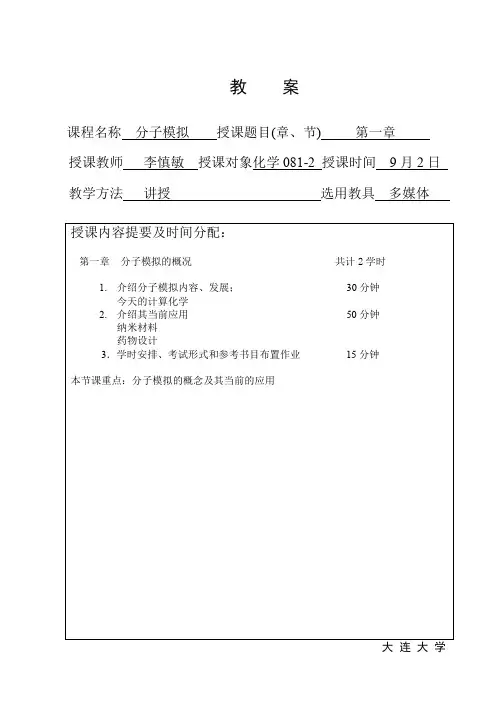
教案课程名称分子模拟授课题目(章、节) 第一章授课教师李慎敏授课对象化学081-2 授课时间9月2日教学方法讲授选用教具多媒体本教案以讲授一个单元(2—4学时)或一次实验(实习)为单位填写。
填写要用钢笔,字迹要清晰、工整。
按表项目逐一填写。
教案课程名称分子模拟授课题目(章、节) 第二章授课教师李慎敏授课对象化学081-2 授课时间9月9日教学方法讲授选用教具多媒体本教案以讲授一个单元(2—4学时)或一次实验(实习)为单位填写。
填写要用钢笔,字迹要清晰、工整。
按表项目逐一填写。
教案课程名称分子模拟授课题目(章、节) 第三章授课教师李慎敏授课对象化学081-2 授课时间9月16 日教学方法讲授选用教具多媒体本教案以讲授一个单元(2—4学时)或一次实验(实习)为单位填写。
填写要用钢笔,字迹要清晰、工整。
按表项目逐一填写。
教案课程名称分子模拟授课题目(章、节) 第三章授课教师李慎敏授课对象化学081-2 授课时间9月23 日教学方法讲授选用教具多媒体本教案以讲授一个单元(2—4学时)或一次实验(实习)为单位填写。
填写要用钢笔,字迹要清晰、工整。
按表项目逐一填写。
教案课程名称分子模拟授课题目(章、节) 第四章授课教师李慎敏授课对象化学081-2 授课时间10月9日教学方法讲授选用教具多媒体本教案以讲授一个单元(2—4学时)或一次实验(实习)为单位填写。
填写要用钢笔,字迹要清晰、工整。
按表项目逐一填写。
教案课程名称分子模拟授课题目(章、节) 第四章授课教师李慎敏授课对象化学081-2 授课时间10月14日教学方法讲授选用教具多媒体本教案以讲授一个单元(2—4学时)或一次实验(实习)为单位填写。
填写要用钢笔,字迹要清晰、工整。
按表项目逐一填写。
教案课程名称分子模拟授课题目(章、节) 第五章授课教师李慎敏授课对象化学081-2 授课时间10月21 日教学方法讲授选用教具多媒体本教案以讲授一个单元(2—4学时)或一次实验(实习)为单位填写。

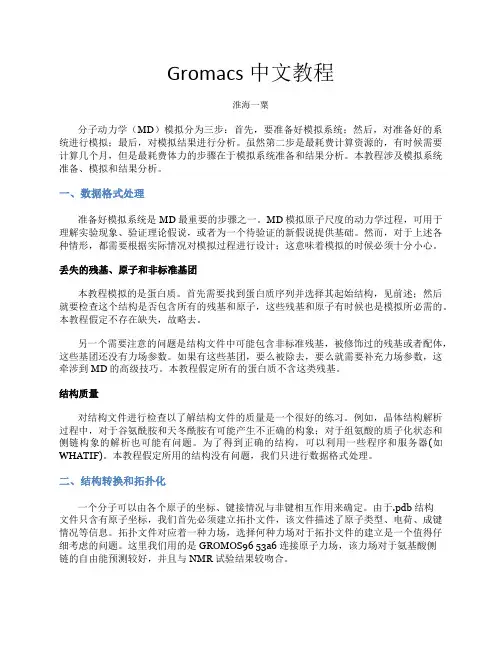
Gromacs中文教程淮海一粟分子动力学(MD)模拟分为三步:首先,要准备好模拟系统;然后,对准备好的系统进行模拟;最后,对模拟结果进行分析。
虽然第二步是最耗费计算资源的,有时候需要计算几个月,但是最耗费体力的步骤在于模拟系统准备和结果分析。
本教程涉及模拟系统准备、模拟和结果分析。
一、数据格式处理准备好模拟系统是MD最重要的步骤之一。
MD模拟原子尺度的动力学过程,可用于理解实验现象、验证理论假说,或者为一个待验证的新假说提供基础。
然而,对于上述各种情形,都需要根据实际情况对模拟过程进行设计;这意味着模拟的时候必须十分小心。
丢失的残基、原子和非标准基团本教程模拟的是蛋白质。
首先需要找到蛋白质序列并选择其起始结构,见前述;然后就要检查这个结构是否包含所有的残基和原子,这些残基和原子有时候也是模拟所必需的。
本教程假定不存在缺失,故略去。
另一个需要注意的问题是结构文件中可能包含非标准残基,被修饰过的残基或者配体,这些基团还没有力场参数。
如果有这些基团,要么被除去,要么就需要补充力场参数,这牵涉到MD的高级技巧。
本教程假定所有的蛋白质不含这类残基。
结构质量对结构文件进行检查以了解结构文件的质量是一个很好的练习。
例如,晶体结构解析过程中,对于谷氨酰胺和天冬酰胺有可能产生不正确的构象;对于组氨酸的质子化状态和侧链构象的解析也可能有问题。
为了得到正确的结构,可以利用一些程序和服务器(如WHATIF)。
本教程假定所用的结构没有问题,我们只进行数据格式处理。
二、结构转换和拓扑化一个分子可以由各个原子的坐标、键接情况与非键相互作用来确定。
由于.pdb结构文件只含有原子坐标,我们首先必须建立拓扑文件,该文件描述了原子类型、电荷、成键情况等信息。
拓扑文件对应着一种力场,选择何种力场对于拓扑文件的建立是一个值得仔细考虑的问题。
这里我们用的是GROMOS96 53a6连接原子力场,该力场对于氨基酸侧链的自由能预测较好,并且与NMR试验结果较吻合。

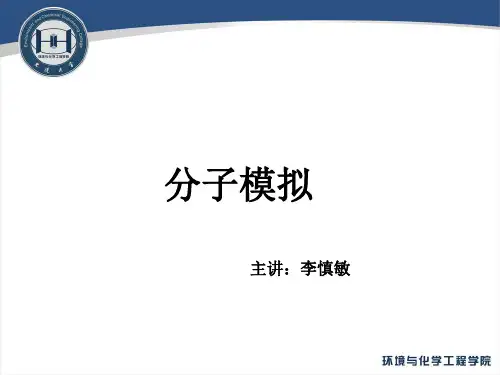
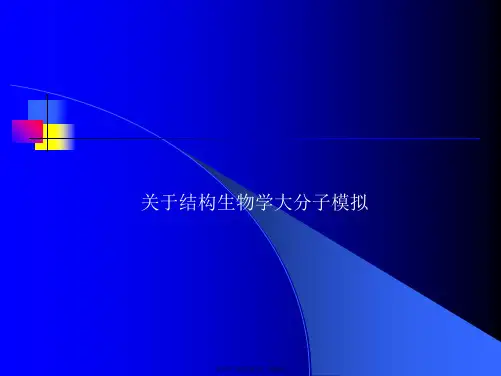

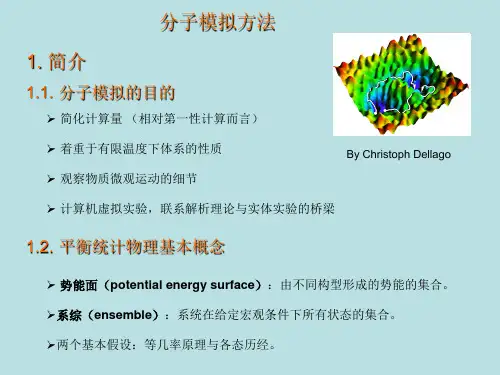
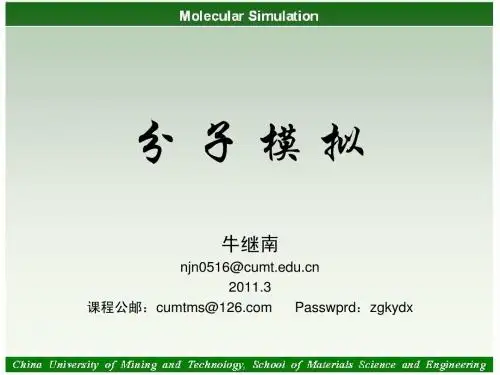
分子动力学模拟IGromacs中文教程淮海一粟分子动力学(MD)模拟分为三步:首先,要准备好模拟系统;然后,对准备好的系统进行模拟;最后,对模拟结果进行分析。
虽然第二步是最耗费计算资源的,有时候需要计算几个月,但是最耗费体力的步骤在于模拟系统准备和结果分析。
本教程涉及模拟系统准备、模拟和结果分析。
一、数据格式处理准备好模拟系统是MD最重要的步骤之一。
MD模拟原子尺度的动力学过程,可用于理解实验现象、验证理论假说,或者为一个待验证的新假说提供基础。
然而,对于上述各种情形,都需要根据实际情况对模拟过程进行设计;这意味着模拟的时候必须十分小心。
丢失的残基、原子和非标准基团本教程模拟的是蛋白质。
首先需要找到蛋白质序列并选择其起始结构,见前述;然后就要检查这个结构是否包含所有的残基和原子,这些残基和原子有时候也是模拟所必需的。
本教程假定不存在缺失,故略去。
另一个需要注意的问题是结构文件中可能包含非标准残基,被修饰过的残基或者配体,这些基团还没有力场参数。
如果有这些基团,要么被除去,要么就需要补充力场参数,这牵涉到MD的高级技巧。
本教程假定所有的蛋白质不含这类残基。
结构质量对结构文件进行检查以了解结构文件的质量是一个很好的练习。
例如,晶体结构解析过程中,对于谷氨酰胺和天冬酰胺有可能产生不正确的构象;对于组氨酸的质子化状态和侧链构象的解析也可能有问题。
为了得到正确的结构,可以利用一些程序和服务器(如WHATIF)。
本教程假定所用的结构没有问题,我们只进行数据格式处理。
二、结构转换和拓扑化一个分子可以由各个原子的坐标、键接情况与非键相互作用来确定。
由于.pdb结构文件只含有原子坐标,我们首先必须建立拓扑文件,该文件描述了原子类型、电荷、成键情况等信息。
拓扑文件对应着一种力场,选择何种力场对于拓扑文件的建立是一个值得仔细考虑的问题。
这里我们用的是GROMOS96 53a6连接原子力场,该力场对于氨基酸侧链的自由能预测较好,并且与NMR试验结果较吻合。